A Low Income Housing Needs and Affordability for Thailand’s Strategic National Plan During 2017-2037
Main Article Content
Abstract
This paper has developed a model to forecast the housing needs and affordability of the low-income households in Thailand 2018-2037. The model has applied the baseline data from the socioeconomic survey (SES 2015). Considering official population projections by the changing age structure and household formations based on income, forecasts can be made about housing needed by ‘Renters’, who are the target group of the low-income households. Given, heuristic scenarios on households’ income growth
over time, an initial planning model for affordable units of housing by types for renters has been proposed.
Effective government policy to mobilize social resource for this low-income household is needed. It is shown that in the long-run, as mean income rises with changing income distribution, households can rely more on the private market provision of housing supply. The model can easily be used for Strategic National Planning by changing assumptions and parameters by the National Housing Authority of Thailand. The NHA in partnership with CODI can solidly plan for the role of low-income housing policy with government intervention on interest rates, terms loan and other policy instruments such as tax exemption for the land sharing in the housing and community development. This paper suggests meta-planning of an urban city model study where NHA, CODI will work together in partnership with other government agencies, the private sector, financial institutions, and academics
Article Details

This work is licensed under a Creative Commons Attribution-NonCommercial-NoDerivatives 4.0 International License.
References
Harmon, O. R. (1988). The income elasticity for single family owner-occupied housing: An empirical reconciliation. Journal of Economic 24, 173-185.
Hasen, J. P. S., & Kristensen, J. (2013). Household formation and housing demand forecasts. Retrieved from https://ideas.repec.org/p/dra/wpaper/201308.html
Isaac F. Megbolugbe, Allen P. Marks, & Mary B. Schwartz. (1991).The economic theory d emand: A critical review. Journal of Real Estate Research, 6(3), 381-393.
Johnson, T. (1997 and 2004). Estimation of housing demand during the 8th National Economic and Social Development Plan (1997-2001), The 9th National Economic and Social Development Plan (2002-2006) and the 10th National Economic and Social Development Plan (2007- 2011). Bangkok: The National Housing Authority.
Land Institute Foundation. (2009). A study of housing indicators for strategic planning. Bangkok: The National Housing Authority.
Limskul, K., & Pattanapong, N. (2018). Asia social infrastructure estimate: The case of Thailand, in case study of social infrastructure demand estimates in Indonesia and Thailand. Bangkok: JICA Research Institute. Retrieved from https://www.jica.go.jp/jica-ri/publication/booksandreports/ 20180831_02.html
Macedo, J., Nguyen, D., O’Dell, W. J., & Smith, M. T. (2005). Affordable housing needs assessment methodology: the adaptation of the Florida model to Brazil. Retrieved from https://www.researchgate.net/publication/5129128.
Megbolugbe, I. Marks, A., & Schwartz, M. (1991). The economic theory demand: A critical review. Journal of
Real Estate Research, 6(3), 381-393.
Meier, S. C., & Labuski, C. M. (2013). The demographics of the transgender population. In International handbook on the demography of sexuality. DOI:10.1007/978-94-007-5512-3_16
Harmon, O. R. (1988). The income elasticity for single-family owner-occupied housing: An empirical reconciliation. Journal of Economic, 24, 173-185.
Sukhothai-Thammathirat Open University. (2004). Study and analysis of housing demand model. Bangkok: The National Housing Authority.
The Institute for Population and Social Research, Mahidol University. (n.d.). Estimates of housing demand during the 12th National Economic and Social Development Plan (2017-2021). Bangkok: The National Housing Authority.
The Thailand Development Research Institute. (2009) The study estimated housing demand during 2009 - 2019. Bangkok: The National Housing Authority.
Whitehead, C., Monk, S., Clarke, A., Holmans, A., & Markkanen, S. (2008). Measuring housing affordability: A review of data sources. Cambridge: Cambridge Centre for Housing and Planning Research, Department of Land Economy, University of Cambridge.

